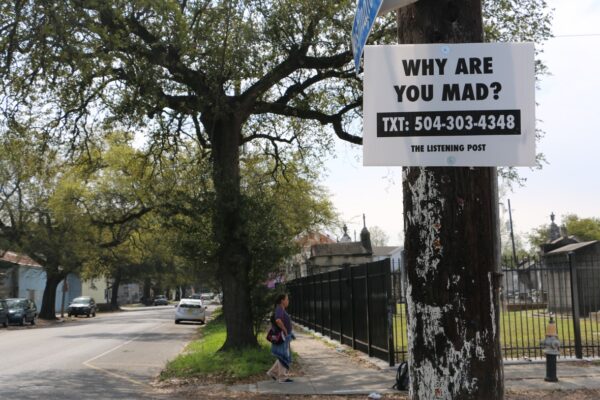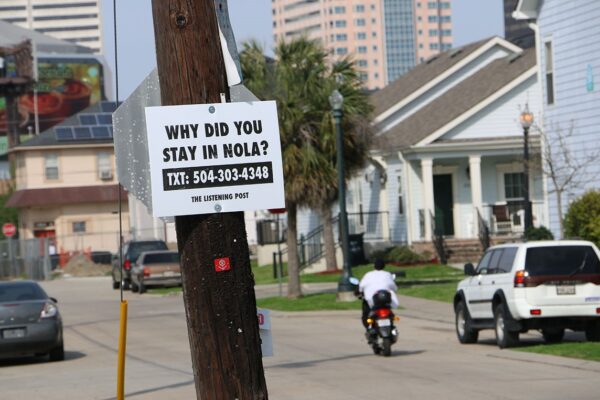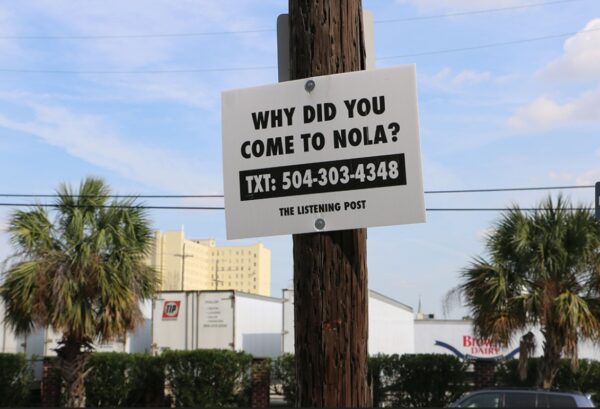
Asking Questions on the Streets of New Orleans
by Jesse Hardman –this article was originally published in 2016 as part of the digital In-Context Journal
I moved to New Orleans because of a question. I was sitting having a beer with a local reporter who had just been tasked with creating a new news department, but didn’t have funding for any staff. “How do you cover a city without any reporters?,” she asked. It was an interesting question to say the least, so I moved South from New York to find out what the answer might be.
I’ve spent the last three years developing the Listening Post, a project that creates an expansive conversation around New Orleans about what’s happening in the city, and how that news impacts families. The project focuses on marginalized neighborhoods that are often spoken for by media, instead of offered an opportunity to represent themselves.
The core tenant of the Listening Post is planting questions in communities and encouraging citizens to share their experiences with a variety of issues: public health, education, jobs, housing, policing, safety, culture, the environment, women and children, and more. And when I say planting questions, I mean literally.

About a year ago I put up 100 signs around the city, on street corners, main thoroughfares, embedded deep in neighborhoods, with a variety of questions on them. Some were more pointed than others, but the idea was to get people talking, and participating in a conversation. And, well, people jumped in. “What’s Missing In New Orleans?” I asked through my sign, and people responded, much to my delight:
- You wanna know what’s missing in New Orleans? a lot. We need better schools that actually TEACH children, crimes off the streets, better systems, homeless people off that street also! There’s many old houses you guys could fix up and give them to the homeless.
- Most parts of the roads
- A mayor for the citizens, not his political legacy.
- Trader joes! Also we need recycling receptacles at the festivals for plastic metal and glass, and compost.
- My wallet
I’ve tried a variety of methods on building participation in my project. Partnering with a public radio station, my initial thought was to capture voices, so I set up stand-alone recording devices in places where people naturally congregate, libraries, grocery stores, community centers. And people definitely are willing to record, but I also wanted to catch the lightning in a bottle, at least for now, that is a cell phone, and see if I could get people using that ubiquitous device to think deeply about what’s happening everyday in this city. That’s where the signs came in.
I use a text messaging platform that enables me to get a phone number out into the community, and then when people text in, see the results, and respond back with an explanation of what the Listening Post is. Then, if people want to stay in the project, they get bi-weekly news surveys from me on their phones, which include a news headline, and a series of three questions based on that topic. Sometimes they jump in, sometimes they don’t, but at this point, around 1,500 folks, all over the city, hear from me on a regular basis.
 What I’ve learned in my attempt to engage a city on important issues through both new and old methods, is that it’s all in the question. I spend hours trying to decide how to ask a question in a way that will maximize participation, but also get me deep answers, that only that specific respondent could articulate. You want to set up your audience to succeed, and not feel excluded by the question itself.
What I’ve learned in my attempt to engage a city on important issues through both new and old methods, is that it’s all in the question. I spend hours trying to decide how to ask a question in a way that will maximize participation, but also get me deep answers, that only that specific respondent could articulate. You want to set up your audience to succeed, and not feel excluded by the question itself.
For instance, I wanted to explore a growing cloud of gentrification that’s hovering over New Orleans. But simply asking, “how do you feel about gentrification?” is too loaded, and also exclusive, not everybody has a good sense of what that means. I’d been noticing that in many of the neighborhoods where traditional New Orleans families were being displaced to, because of a lack of affordable housing, an army of dollar stores were popping up. It turns out there’s an algorithm for developers deciding where to put a dollar store. It doesn’t mean your neighborhood is becoming lower income, it means developers decided it already did. So I asked people “how many dollar stores are in walking distance of your house?” Then I asked people how they use those stores, because dollar stores often become the de-facto grocery store in neighborhoods isolated by poverty. Here are a few responses people texted in:
- 7 dollar stores. Maybe 2-5 times a week
- Groceries mostly, and paper products sometimes
- There isn’t many big grocery stores in my area of St. Bernard parish
- Two, I shop there at least three times a month
- Household products and food items
- 5 and counting dollar stores, I shop there once a month, usually buy greeting cards 🙂
I spend more than half of my time on this project trying to craft queries that will get me information and anecdotes from a wide range of people, highly educated and not, smart phones and flip phones, overworked and unemployed, and everyone in between.
There’s also a simple success in this endeavor in that for a lot of people, engaging them, and simply making sure they see the question means they are being invited in, to be heard, to participate, to know something. Even if they don’t ultimately respond, they were included. That’s a powerful act. One, as somebody who works in media, that makes me sleep better at night, knowing that I met people in their spaces, on their street corners, on their phones, and at least tried to reach everybody.
